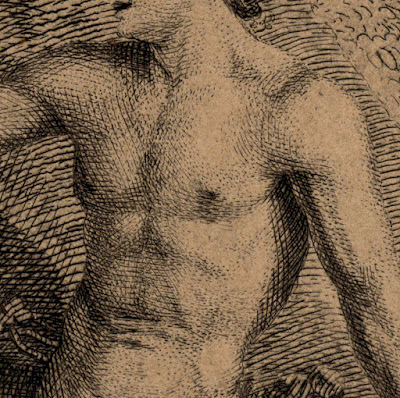Martin Rota (aka Martino Rota; Martin Rota Kolunić; Martinus
Rota Sebenicensis) (c.1520–83)
“Christ as the
Man of Sorrows", 1568,
published by Nicola Nelli (c.1530–post 1576)
Engraving on
fine laid paper, trimmed at the platemark, marked with the monogram of the
publisher “NN” (Nicola Nelli), dated on the plate at centre of lower edge, “1568”,
and lettered on the side of the sarcophagus cover (partly decipherable) with the acronym: “M · R · S · F” (Martin Rota Sebenicensis
Fecit)
Size: (sheet)
17.1 x 13.4 cm
Condition: this
is a print of the utmost rarity (it may even be a unique copy) with a few very
small abrasions otherwise in excellent condition. The sheet is trimmed to the
platemark and there is a pint hole towards the lower right corner. There are
ink and pencil inscriptions (verso) along with a collector’s stamp “FA.”
I am selling
this small masterpiece for a total cost of AU$460 (currently US$347/EUR324.81/GBP276.78
at the time of this listing) including postage and handling to anywhere in the
world.
If you are
interested in purchasing very rare, museum quality print, please contact me
(oz_jim@printsandprinciples.com) and I will send you a PayPal invoice to make
the payment easy.
This print has been sold
This simple but
very beautiful engraving has almost been the death of me over the last three
days. As an act of sharing my woes and unburdening my angst onto others, I’ve
decided to give an account of my adventures.
My journey of
discovery began when I decided to separate the sheet from the backing board
onto which it was glued. I needed to do this operation as I could see glimpses
of inscriptions on the back of the sheet that looked interesting and, more
important, the glue used for attaching the sheet to the backing board had
stained its way through to the front of the sheet marring the image. For this
operation, I simply laid the print and its backing board in a bath of water
(with no chemical additives) for an evening dip. In the morning I was relieved
to find that the print was floating above the backing board and the glue (whatever
it was) had dissolved away completely and even the stain on the front of the
image had miraculously disappeared. Marvellous.
After drying
the print, I examined its back. At the very top of the sheet (verso) I saw
pencils numbers that I assumed were a collector’s catalogue references and
below them, an ink inscription written in an old but dreadful hand that I assumed
to be a previous collector’s name: “Grauwels Bruse”. Further down, I saw an
ink-stamped monogram of entwined initials, “FA”, no doubt another past
collector, but my interest didn’t lead me to try to identify who this might be.
Instead my eyes were fixated on the pencil inscription: “Martin Rota
Sibenicensis fecit.” This name seemed to verify that the print was by Rota as I
had purchased it from a dealer as a genuine Rota. Alas, this is the beginning
of my woes.
I consulted the
Bartsch catalogue raisonné for Rota (1979, Vol. 33) never expecting even for a
moment that I would have difficulty in finding the print with its title and Bartsch
number. I was in shock, however, as it wasn’t there. I then checked on the
British Museum’s holdings of Rota prints and they didn’t have it either. I then
checked everywhere and no museum had this print. I was VERY uneasy!
Next, came the
painful process of verifying that this print was a genuine Rota despite the
fact that it wasn’t listed ANYWHERE. And so began the painstaking process of
comparison of small details in this print with verified—Bartsch approved—prints
by Rota. At this point, I can say with deep satisfaction that I now know more
than I did before about the way that Rota renders woodgrain on crosses. Moreover,
from endless comparisons with other artists’ versions of “Christ as the Man of
Sorrows” executed in much the same time period, I now know that very few
artists portray Christ with a well-toned six-pack as depicted by Rota in his
prints. For example, Israhel van Meckenem (c.1445–1503) in his “Gregorian Man
of Sorrows” (Bartsch 9[6].135[251]) shows Christ with a stretched and sunken
abdomen appropriate for a man who has just been crucified.
The final stage
in my research should really have been the first stage: to study the
inscriptions on the print itself. Up to this stage I had ignored the lettered “NN
exc” inscribed on the side of the tomb as I had assumed that it simply signified
the publisher name, Nicola Nelli, and had little bearing on the name of the
engraver. Of course I was wrong. After consulting the list of 16th
century publishers in “Prints after Giulio Clovio” (1998, see p. 133) I
discovered that Nelli SPECIALISED in publishing Rota’s prints (among other
artists). What also surprised me is that Nelli executed prints in the style of
Rota but “the drawing is inferior to Rota’s” (ibid).
When I read
this remark, depression hit me in the sense that I then assumed that Nelli not
only published the print but also engraved it. The other featured letters shown
on side of the tomb’s cover, “M · R · S · F”, I had no idea what they could
mean. That is, until the thought occurred to me that that they were the first
letters of Rota’s name, an acronym for “Martin Rota Sebenicensis” and the final “F” signifying the all-important
piece of information: Fecit” (i.e. the print was executed by Rota).


















































